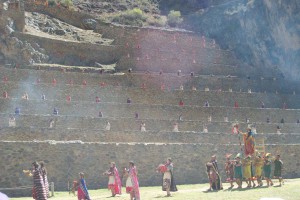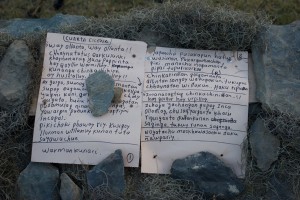A few weeks ago, I was briefly speaking with an elderly woman in the Southern Peruvian Andes, and told her I was on my way to study Quechua in Cusco, upon which she remarked, “ah Cusco, por ahi habla la quechua pura” (Cusco, there they speak the pure Quechua).
Although Cusco was the center of the universe for the Inkas – the navel of the four corners, Tawantinsuyu – it was not the center of the universe to all Andean people, many of whom were subjected to Andean rule, or resisted it outright. And not everyone spoke Quechua.

So, what would make this Andean woman think this? Why do Cusco and Quechua seem to exclusively encompass that which is Andean? That is, why is Cusco the seemingly primordial locus of Andean culture?
In this post I wish to further excavate the complex and dynamic understandings of identity and empires brought into sharp relief amidst cultural and colonial encounters, which can be more adeptly explored through taking a look at language and language ideologies.
Language ideologies reflect the speaker’s awareness of language that is predicated upon taking language as an object of experience (Keane 2007: 17). This form of objectification and the notion of language ideologies was quite distinct in the Andes. Language ideologies influenced local Spanish practices of understanding and use of indigenous languages for their own missionary projects; language was used as a tool for Spanish imperialism and evangelization.
The Inka and Andean cultural groups had very different understandings and practices regarding language from the recently encountered Spaniards. At the time of the Spanish conquest, the Andean landscape was filled with a complex diversity of languages, many of which are now sadly extinct. Of the surviving languages, Aymara and Quechua continue to be prominently spoken in the Andes and have long, entangled histories with many shared words and interesting similarities and differences (Mannheim 1991). The unique relationship between these languages exemplifies the mosaic of ethnic identities and further reflects how Andean social groups were discontinuously settled throughout regions in order to gain access to various ecological resources – known as the “vertical archipelago” (Van Buren 1996). In the prehispanic Andes, language, territory, and polity did not necessarily correspond, demonstrating a fundamental difference from European language ideologies (Durston 2007: 41).

Quechua was considered the language of the Inka empire (however, it is also speculated that there was a secret language of the Inka royal elite). In fact, what the Spanish would identify as the lengua de los Ingas was most likely originally from the Central coast of Peru, just South of Lima. Prior to Spanish colonialism, what we know today as Quechua had no specific name. It was known, just as it is still today, as runasimi – that is, human speech (runa – person, simi – speech). Andean groups did not necessarily have a homogenous and standardized way of understanding language and its relationship to ethnicity and identity. For Andean groups, recognition of language and difference was profoundly influenced by certain local and performative understandings of ethnicity and identity (Mannheim 1991). It wasn’t necessarily, “oh, you speak Spanish,” rather, it was, “that’s different runasimi,” and these differences were not evaluated hierarchically. This contrasts sharply to European language ideologies and is evident in the differences between the Inka and Spanish colonial projects.
When the Spanish arrived to the Andes, they were concerned with communicating the “word of God,” which they could not do in Spanish in the years following their immediate invasion. Subsequently, Spanish religious officials produced Pastoral Quechua – “the Christian ‘language’ or register in Quechua” (Durston 2007: 3). Spanish colonial language ideology was predominately informed by a Christian universalizing cosmological framework (Hanks 2010). This involved particular “understandings of the relation between language and community and perceptions of linguistic change and diversification as processes of degradation” (Durston 2007: 113-114). Therefore, in evaluating language difference and variation, the Spanish were strongly hierarchical and judgmental— “languages were either closer to or farther from a divine origin, and embodied greater or less civility and sophistication” (Durston 2007: 42-43). The Spanish saw the veritable pantheon of linguistic diversity as a manifestation of the barbaric state of Andean societies, wherein barbarism indicated the “inability to communicate” (Durston 2007: 43).
Based upon European language ideologies, the Spanish assumed that if Quechua was the language of the Inka empire, then it must have followed that its pure or correct form would exist at the empire’s capital, Cusco, which was also believed to be its point of origin (Durston 2007: 112). As Durston eloquently states, “Quechua was thus perceived as a cloth that was whole at the center but had become tattered at the edges” (Durston 2007: 112). This isomorphic framework that assumed language reflected the characteristics of a certain people, also presupposed a singular locus of origin. There is only one God, and he/she is universal. All that is different or divergent from these singular, idealist models is then judged accordingly.
This brings to mind Leon Leid’s wonderful account about questioning assumptions and stereotypes, along with Hannah’s recent post on static representations in museums. To borrow from the French Anthropologist Pierre Clastres, and his classic anthropological work, Society Against the State (Clastres 1977), I wish to ask, why is it that one comes to be considered good in the first place, a singular universalism? What makes something pure? What about embracing the many and cultural differences, but without depriving such differences and multiplicities of their historical dynamism (that is, to not assume static pasts)? Or can there be one and many?
Returning to the brief exchange I had with the Quechua woman in the Southern Andes, it is clear that Spanish colonial and European language ideologies now are strongly ensconced in Andean/Peruvian culture. Historical contingencies and enduring practices reinscribe these ideologies and perspectives. This is evident in one of the few Quechua plays still performed today, Ollantay, which is closely tied to Inka history and identity. With its yearly performance, the play reaffirms a direct relationship between Quechua/runasimi and the Inka of Cusco (perhaps at the expense of other locales and histories in Peru).
I’m sure that upon further conversation it would be clear that this woman, like so many across Peru (where it still occurs in a range of dialects), speaks excellent Quechua and expresses many things in far greater precision than what could be done in the Spanish tongue.
References
Clastres, Pierre 1989 [1974] Society Against the State: Essays in Political Anthropology. Zone Books.
Durston, Alan 2007 Pastoral Quechua: The History of Christian Translation in Colonial Peru: 1550-1650. Notre Dame: University of Notre Dame Press.
Hanks, William 2010 Converting Words. Berkeley: University of California Press.
Keane, Webb 2007 Christian Moderns. Berkeley: University of California Press.
Mannheim, Bruce 1991 The Language of the Inka since the European Invasion. Austin: University of Texas Press.
Van Buren, Mary 1996 «Rethinking the Vertical Archipelago: Ethnicity, Exchange, and History in the South Central Andes. American Anthropologist. Vol 98 (2): 338-351.
